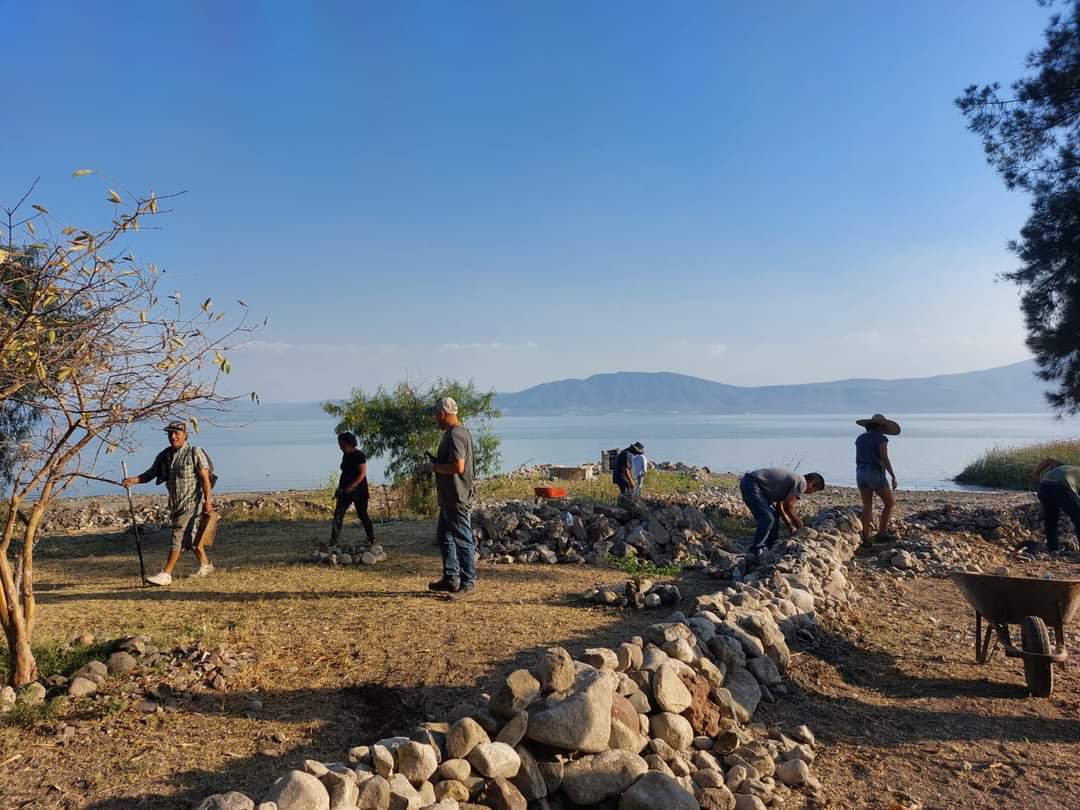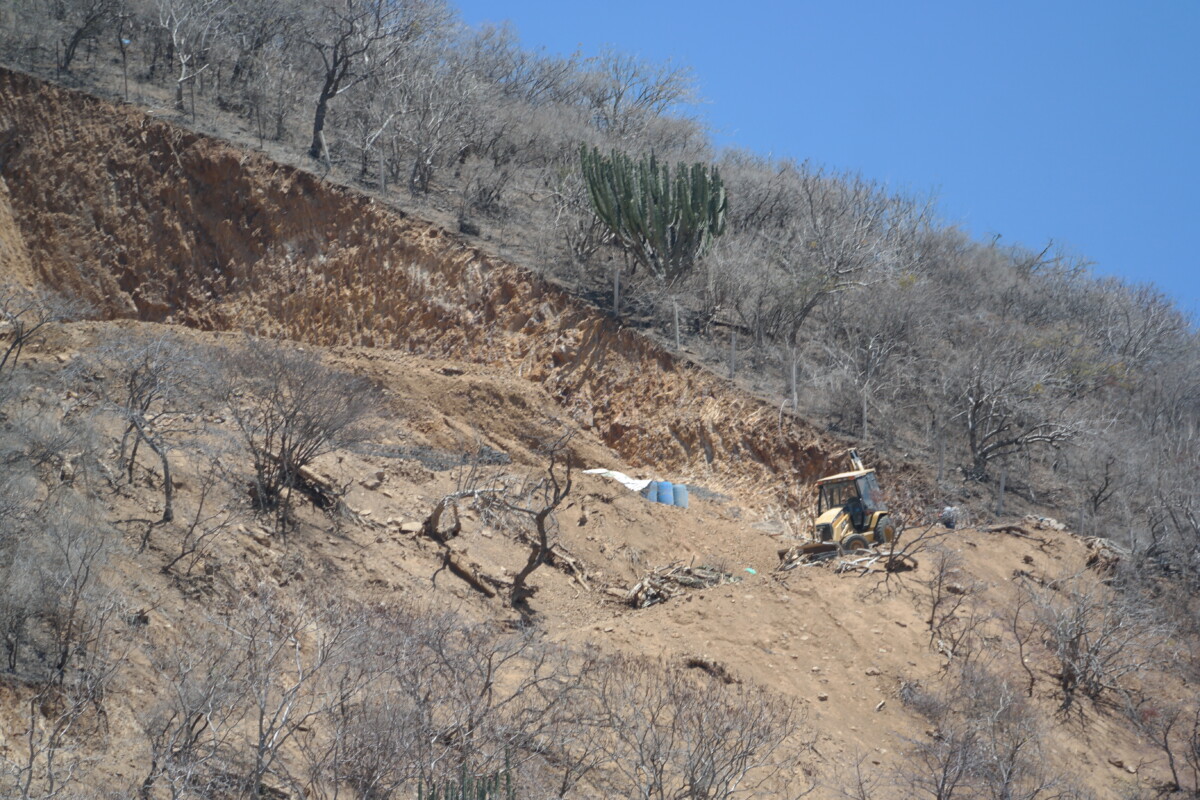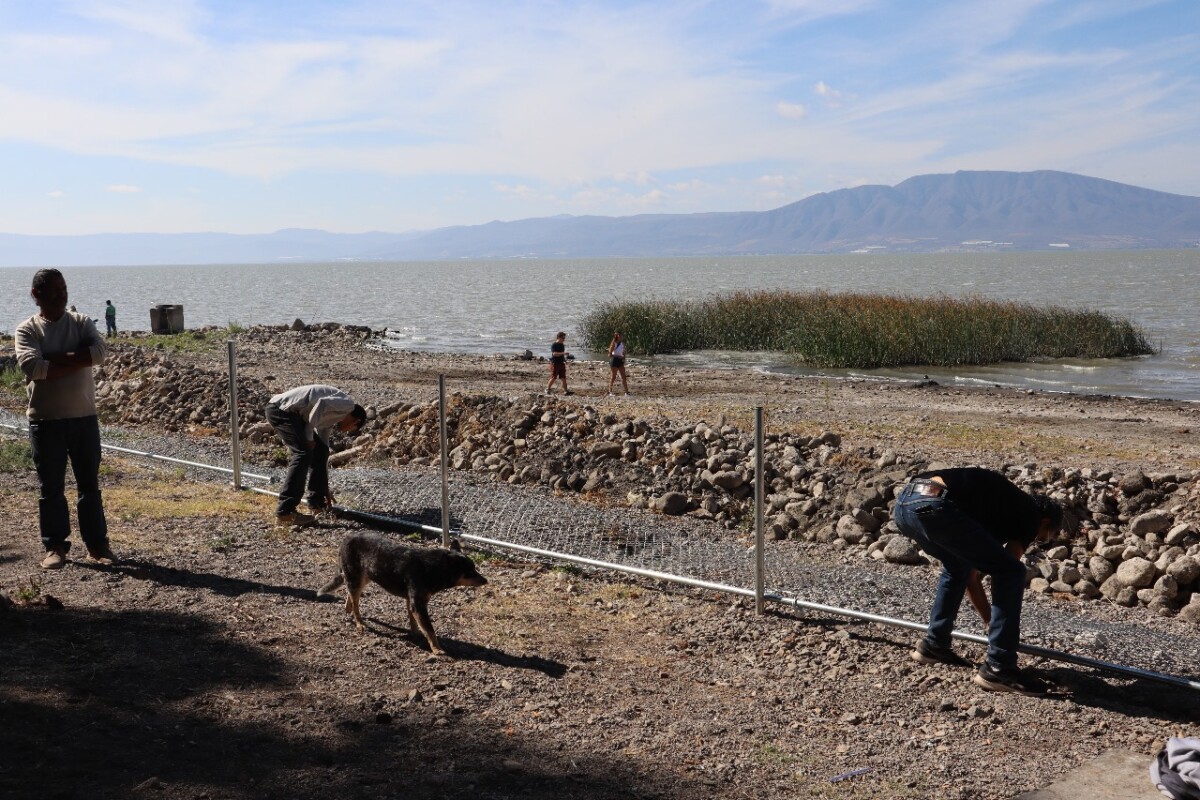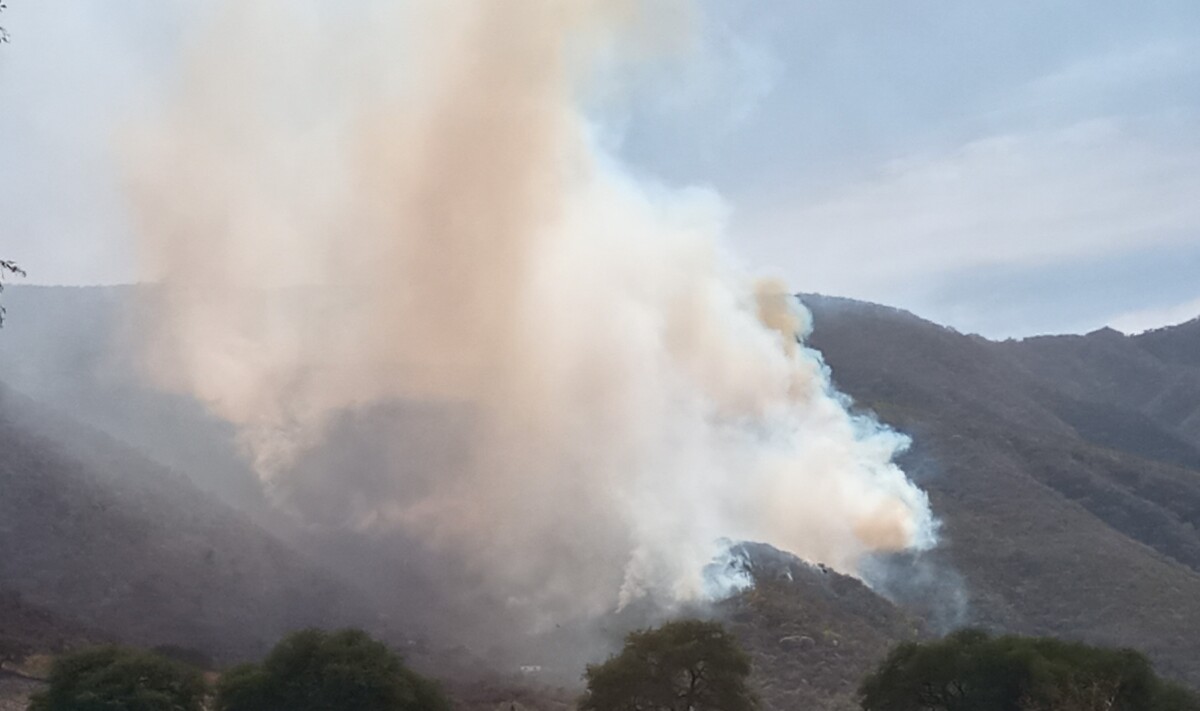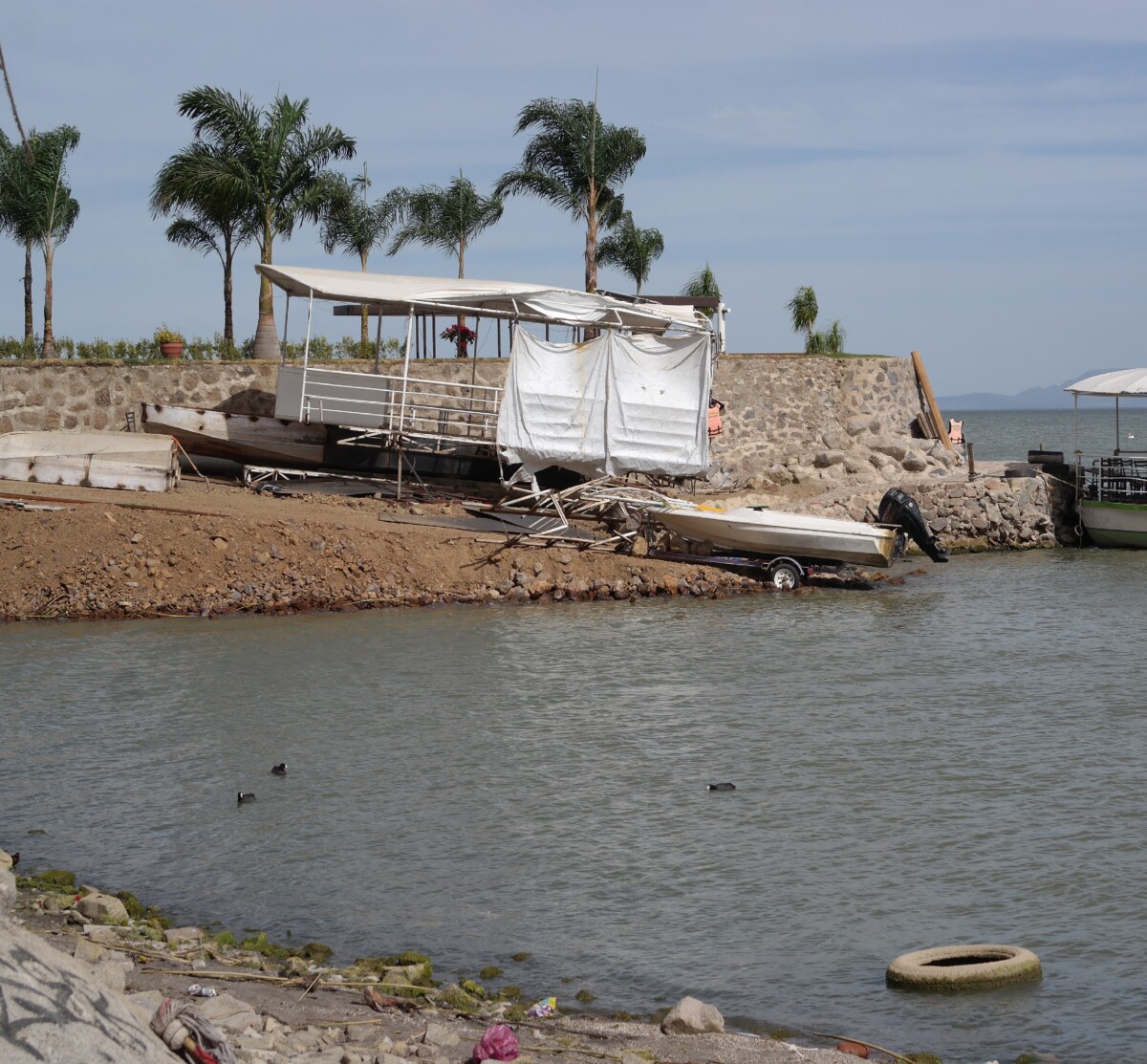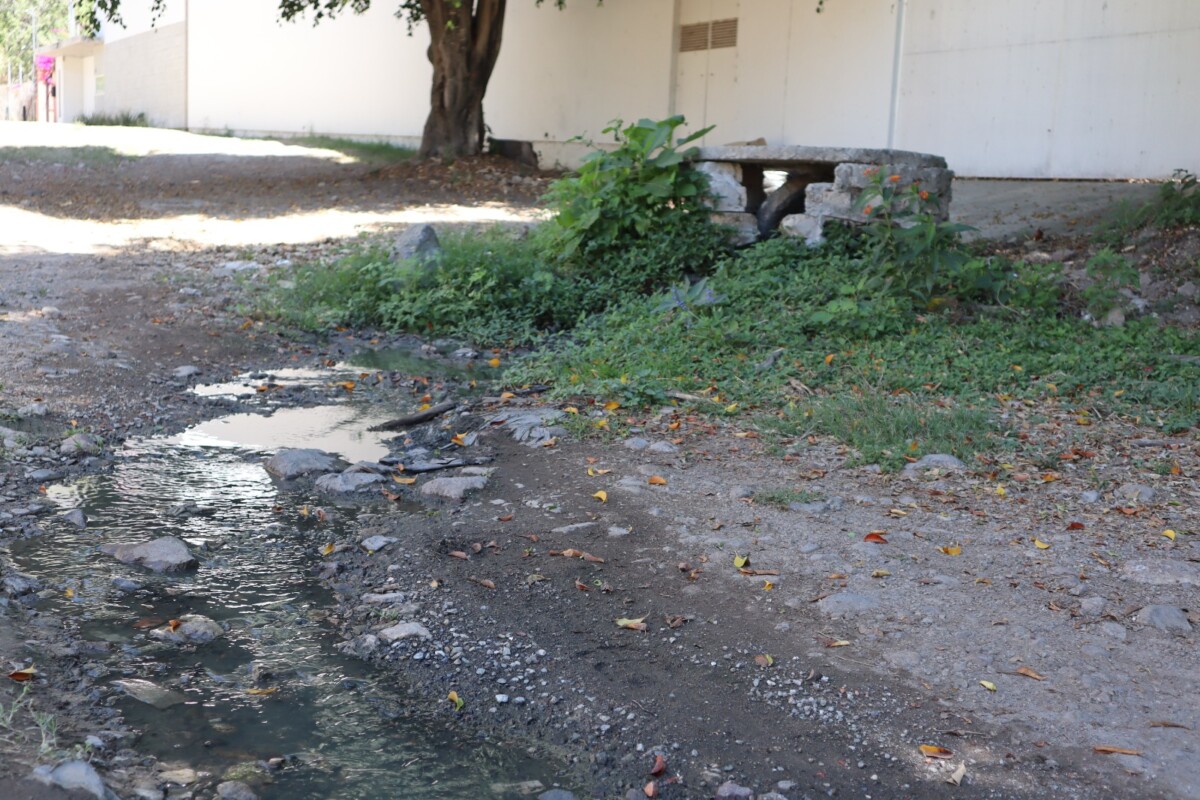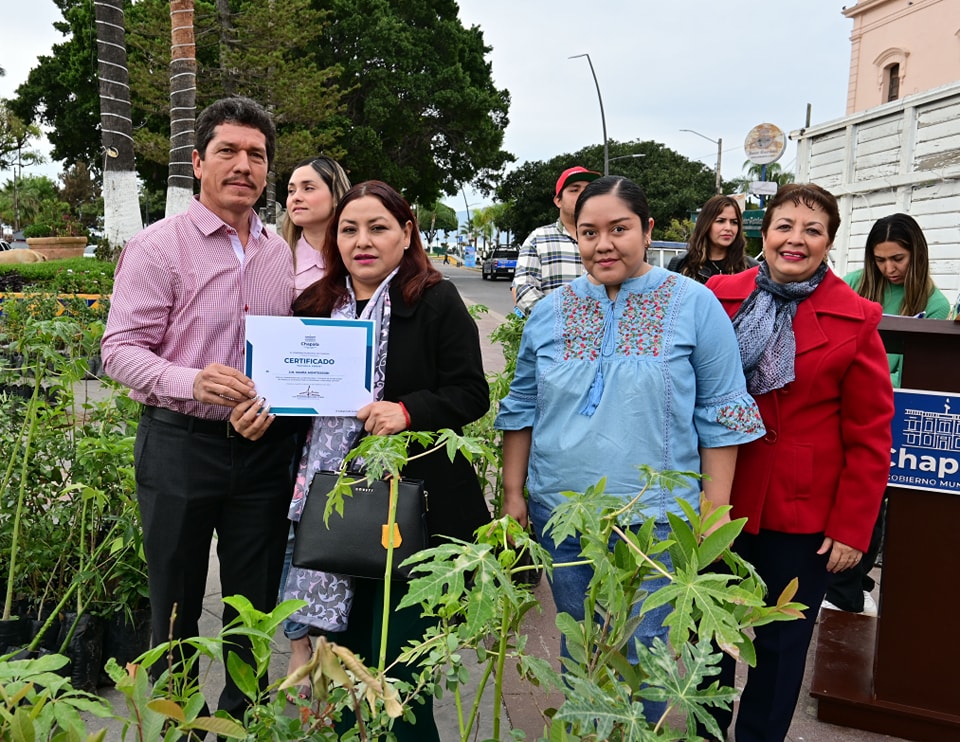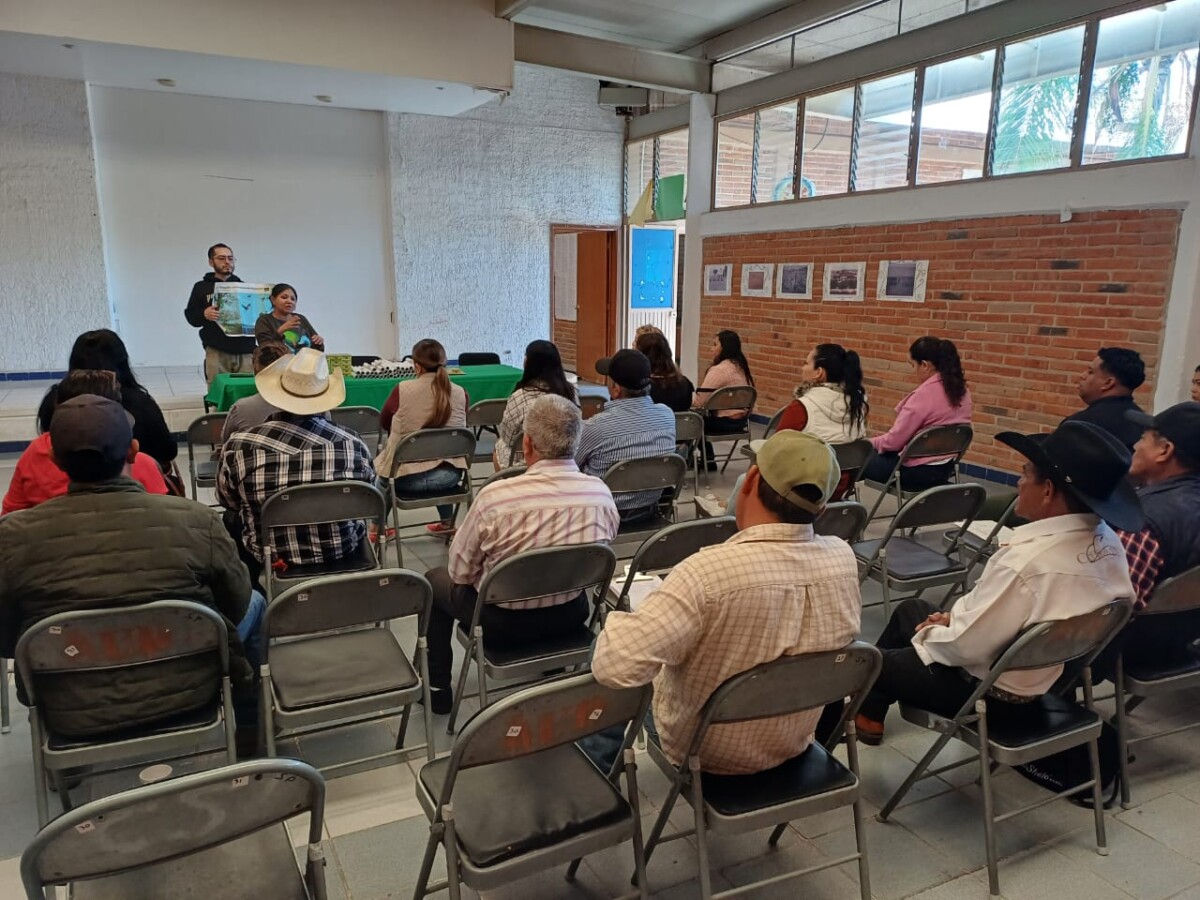Ecología
Pueblo de Ajijic pone manos a la obra en la playa La Crucita
Personas que fueron a apoyar a hacer un pequeño bardeado con piedra de la zona. Foto: Ajijic Observatorio Ciudadano.
Sofía Medeles.- Buscando usar materiales de la zona y sin ser invasivos, se iniciaron con los trabajos de delimitación de la playa de La Crucita, en Ajijic. Un grupo de voluntarios y activistas del poblado, se reunió para empezar con la construcción de una barda de piedra, limpiar y cuidar de los árboles que se plantaron con anterioridad.
Según compartió Julio Carmona, uno de los activistas que se sumó a la convocatoria, el proyecto se ha ido modificando conforme van viendo qué tipo de materiales y árboles pueden utilizar, con el propósito de no ser invasivos y que quede lo más natural y adaptado posible. El sábado 13 de abril iniciaron haciendo una pequeña barda con piedras de la zona.
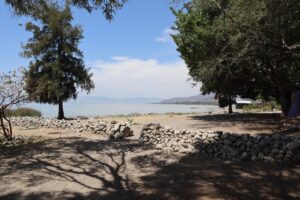
Bardeado realizado con piedra, por personas voluntarias de Ajijic. Foto: Sofía Medeles.
«Lo ideal es que se cierre la zona para que no entren carros ni motos ni nada de eso, pero con elementos naturales, como piedras, rocas, plantas y árboles. Los involucrados, como los biólogos que apoyan, se enfocan en las especies que puedan ser aptas para el lugar», compartió.
El sábado 20 de abril se realizó la primera plantación de árboles, enfocado en niños, para que pudieran asistir a ver el proceso de plantar un árbol, donde además, se les brindó refrigerio donado por voluntarios.
«La intención de este proyecto no es oponerse ni ir en contra del pueblo ni del ayuntamiento, sino de preservar un espacio natural. Hoy en día, cada día todo tiene más cemento, es más artificial. Lo importante es que al menos los niños tengan un espacio natural, porque cada vez todo está más privatizado e invadido», agregó Julio.

También se limpió y acomodó la arena de la zona. Foto: Ajijic Observatorio Ciudadano.
Por otro lado, señaló que la oposición del grupo al proyecto realizado anteriormente por el Gobierno Municipal, se debe a que este tipo de acciones, podrían acarrear a esa zona comercio informal, una cantidad insostenible de gente y por lo tanto, basura. «Preservar un espacio público y natural, es todavía más valioso. Se trabajará con materiales naturales, para que lo que se use se pueda reintegrar a la naturaleza».
La agenda del grupo y las actividades que se lleven a cabo en la zona, se estarán publicando mediante redes sociales, por ejemplo en el grupo de Facebook Ajijic Observatorio Ciudadano, donde también se puede solicitar información para donar y aportar al grupo y al trabajo en la zona. Por ahora, se requieren troncos de madera que sobren de podas.
Conmemora el Instituto Terranova el Día de la Tierra con dinámicas y conferencias
La AC, BioTU llevó actividades interactivas pláticas y conferencias para los alumnos del instituto Terranova. Foto: D. Arturo Ortega.
Redacción. – Con dinámicas interactivas, pláticas y conferencias sobre el cuidado del medio ambiente, el Instituto Terranova conmemoró el Día Internacional de la Madre Tierra, el 22 de abril.
Las actividades dirigidas a los alumnos de educación básica y bachillerato incluyeron juegos interactivos para los grados menores, mientras que para los grados superiores se proyectó un video y conferencia que tuvo alrededor de una hora de duración.
Emilio Bernal Maza, director de Educción e Innovación de la Asociación Civil (AC) BioTU, dedicada a la enseñanza de prácticas sustentables y amigables con el medio ambiente, para escuelas y empresas, habló del objetivo de las actividades realizadas con los alumnos:
“La idea general es que se reconecten con su propia naturaleza, que reconozcan a la Tierra como madre y también que nosotros tenemos que cuidarla para que nos retribuya con los servicios que nos da”, comentó el representante de la AC que tiene su sede en la cabecera municipal de Jocotepec.
El Día Internacional de la Madre Tierra fue establecido en 2009 por la Asamblea General de las Naciones Unidas mediante la Resolución A/RES/63/278. La Resolución fue presentada por Bolivia y respaldada por más de 50 estados miembros.
Otra vez montan maquinaría en cerro de Piedra Barrenada
Una máquina retroexcavadora se encuentra en la zona que se observa con un claro desgaje. Foto: Armando Esquivel.
Armando Esquivel.- Una máquina retroexcavadora regresó a uno de los cerros frente a la zona de Piedra Barrenada, en San Juan Cosalá, mientras que el Gobierno de Jocotepec aseguró que la persona que construye les dijo que sólo haría limpieza para un «sendero»; el raspón en el la montaña es más que visible.
El cerro se encuentra en la última parte de la zona restaurantera, casi en el acceso a San Juan Cosalá, punto en el que desde noviembre del 2023 se observó maquinaría realizando raspones al cerro; el Gobierno de Jocotepec respondió a este medio que no había autorización en esa zona y que hasta se había solicitado un dictamen de impacto ambiental, pero de esto nunca se supo nada.
En diciembre del pasado año, el encargado de Desarrollo Urbano del municipio, José de Jesús Gaytán Cuevas, declaraba que sólo se estaban habilitando caminos que ya existían, con la intención de dejar el sendero libre, asegurando desconocer de los raspones en el cerro y comprometiéndose a revisar el tema.
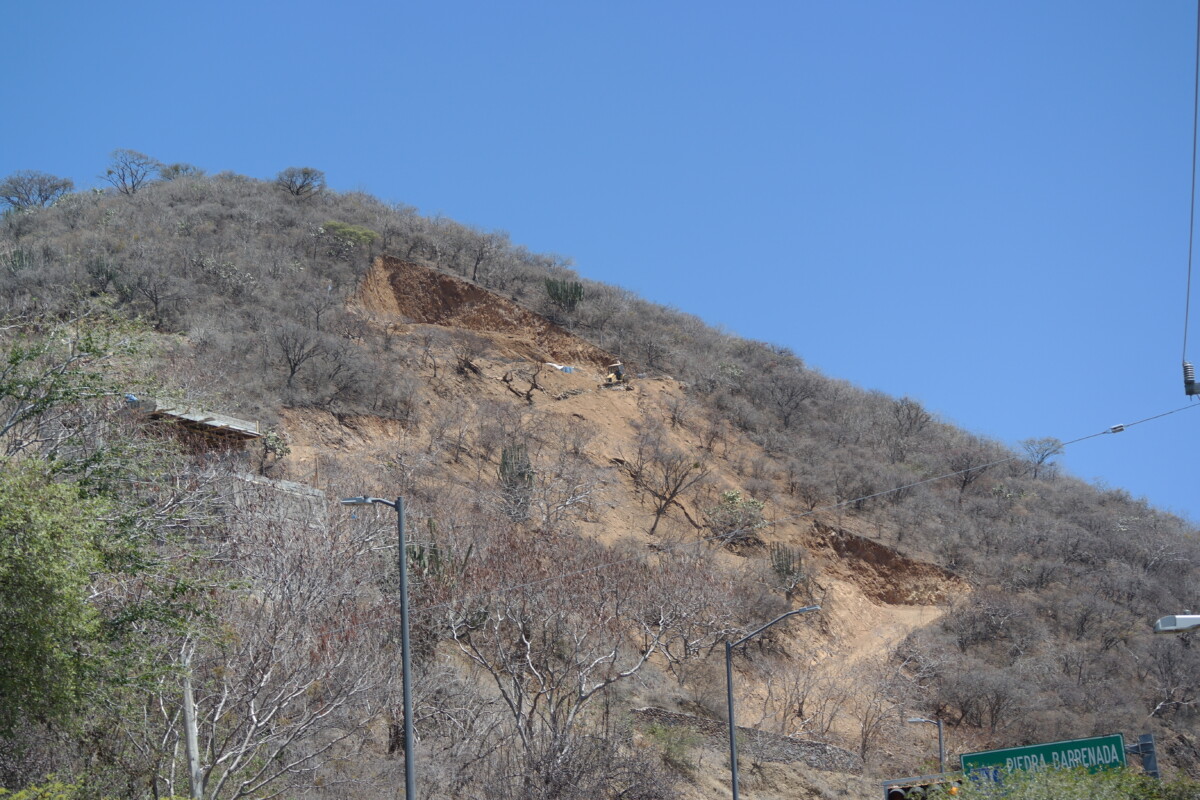
El cerro está ubicado frente al restaurante, “La Iguana de Piedra”, en la zona restaurantera de Piedra Barrenada. Foto: Armando Esquivel
Al ser cuestionado, José Miguel Gómez López, alcalde de Jocotepec, mencionó que el propietario, un restaurantero de la zona, les dijo que limpiaría el lugar en forma de sendero, aunque a simple vista es evidente el raspón realizado al cerro con maquinaría pesada, mismo que nada tiene que ver con un sendero.
“El propietario de La Iguana de Piedra, que está enfrente de ese terreno, que también es de él, nos hizo mención que iba a realizar la limpieza del camino para que pudiera la gente ascender al punto alto de esa parte del cerro, hacer un tipo senderismo y que no iba a realizar ninguna tala de ningún árbol porque sabe que está penado la tala en árboles endémicos, en cualquier árbol, pero preferentemente siempre pedimos que protejan el endémico” contestó el presidente de Jocotepec.
Gómez López también informó que pidió frenar los trabajos hasta tener certeza de qué es lo que se está realizando, cuáles son las afectaciones para el medio ambiente y si representa algún riesgo de deslave.
“Él, la máquina la metió para darle forma al camino, le pedí al director de desarrollo urbano que le frenara y que planteara cuál es el área que va a fectar y que me lo documentaran con fotografías y se realizara única y sencillamente la limpieza del camino, la formación de ese sendero y evitar cualquier posible daño o afectación al lugar, que pueda después generar algún deslave o también que pueda realizar la tala de árboles que no están autorizados y en eso está” dijo el primer edil de Jocotepec.
Por lo pronto el raspón está hecho y se desconoce si el Ayuntamiento de Jocotepec seguirá dando luz verde a los trabajos, mismos que han estado en la ignorancia del gobierno municipal.
‘Madruga’ Ayuntamiento a activistas para remover la malla en Ajijic
Remoción de la malla ciclónica que rodeaba la playa de La Crucita. Foto: Sofía Medeles.
Sofía Medeles.- A aproximadamente dos semanas de haberla instalado, el Gobierno de Chapala removió la malla ciclónica que delimitaba la playa de La Crucita, debido a la creciente desaprobación por parte de algunos pobladores de Ajijic, así como para «cuidar la inversión», según compartió el presidente interino de Chapala, Gamaliel Soto Pérez.
El pasado martes 2 de abril, ante el aviso de que varios activistas en pro de la liberación del terreno federal se reunirían para retirar la malla ciclónica a las 9 de la mañana, las autoridades municipales se anticiparon a comenzar con la remoción. En un video publicado media hora antes, Soto Pérez dio a conocer el motivo.
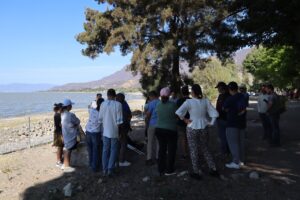
Activistas que se manifestaron en contra, dialogando con autoridades municipales. Foto: Sofía Medeles.
«La intención de la instalación de esta malla era para proteger a los ocupantes, a los visitantes y locales de este espacio que la comunidad ha acomodado al paso del tiempo. Durante la Semana Santa tuvimos saldo blanco, unas personas acamparon y disfrutaron de este espacio. Queremos decirles que hubo muchas voces que se manifestaron inconformes con la instalación de esta malla que era para proteger, se está removiendo para cuidar la inversión que se ha hecho, pero nos gustaria escuchar sus opiniones para reunirnos y seguir mejorando los espacios públicos, que si bien, es cierto no son del municipio, si los utilizan todas las personas que aquí vivimos».
Aun así, activistas se reunieron para encontrarse con el encargado de despacho de Ajijic, Timoteo Aldana Pérez, así como el regidor suplente, Jesús Medeles Córdova, quienes dialogaron con los manifestantes, tomando en cuenta sus opiniones.
Entre los comentarios, se mencionó que las playas deben de ser libres y estar abiertas, que no era necesario atraer la atención de turistas y visitantes a esa zona, sobre la colocación de baños y alternativas para evitar el paso de vehículos, como delimitar el lindero de la zona con árboles.
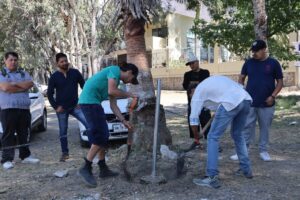
Activistas retirando postes para sembrar árboles. Foto: Sofía Medeles.
El regidor suplente, Jesús Medeles, compartió que los acuerdos principales fueron en primer lugar quitar la malla, evitar el paso de vehículos en la zona, delimitar de manera natural el espacio y mantener la vigilancia.
«Estamos de acuerdo que sea un espacio para la gente, esparcimiento y recreación familiar. […] Hay gente interesada en proponer, la comunidad hará sus acciones, y adelante. Estaría bien que hiciéramos una activación cultural y comunitaria del espacio para apropiarnos porque es de todos, vamos buscando el mejor consenso».
Por su parte, el encargado de despacho, Timoteo Aldana, dijo tras los comentarios emitidos de que no estaban de acuerdo con los baños, a menos que fueran ecológicos, que ese espacio no era para quedarse mucho tiempo, y que la iluminación y baños daría espacio a eso; en cuanto a la iluminación en la zona y los baños que se planeaba construir ahí, se tomaría la decisión con base a las opiniones.
«Está en consenso. Si dicen que no quieren ni iluminación ni baños, no se pondrán, no hay problema». Por otro lado, se comentó que la malla retirada se utilizará en otro espacio, para darle uso.
Medeles Cordova coincidió en que las obras municipales tienen que ser socializadas antes de ser ejecutadas. «Así tiene que ser en todo, tienen razón en buscar la socialización, las obras tienen que ser socializadas por más pequeñas que sean. Quienes pusieron esta malla tenían la mejor intención, pero no fue una ejecución adecuada».
Algunos de los activistas que asistieron se mostraron conformes que por primera vez durante la administración, se abrió un espacio al diálogo, y no se impuso la obra hasta terminar, como pasó en otros casos, como las remodelaciones de las calles Colón y Ocampo.
Los asistentes iniciaron sembrando alrededor de 10 árboles para delimitar la zona, con la promesa de continuar con la siembra y el cuidado de los árboles. Además, quedaron de acuerdo en mantenerse en vigilancia como poblado, para poder hacer frente a situaciones que no se socializan.
Sospechan de intervención humana en mega incendio forestal
Incendio forestal durante la mañana del segundo día de fuego en cerros de Ixtlahuacán de los Membrillos. Foto: Armando Esquivel.
Armando Esquivel.- La mano del hombre es la probable causa del incendio forestal que consumió 522 hectáreas de zona montañosa entre Ixtlahuacán de los Membrillos y Chapala durante más de 10 días y a decir de Protección Civil y Bomberos tuvieron llamas que alcanzaron los 20 metros de altura, dejando afectaciones a especies animales así como en el suelo y la vegetación, que según personal de la Asociación Intermunicipal para la Protección del Medio Ambiente y Desarrollo Sustentable del Lago de Chapala (AIPROMADES) tardarían hasta siglos para su recuperación.
¿QUIÉN FUE?
Conocer con precisión la causa del voraz incendio es casi imposible, aunque sin afirmarlo como tal, Rodolfo Franco Quintero, Coordinador General de Protección Civil y Bomberos de Ixtlahuacán de los Membrillos, dijo que basándose en la estadística y la experiencia, considera que hubo intervención humana.
“No tenemos un dato de cómo inició el fuego, no tenemos indicios, no sabemos absolutamente nada, pero sí quiero recalcar que los incendios en estas áreas normalmente son ocasionados por la mano del hombre”, dijo en entrevista para Semanario Laguna.
Fue el sábado 23 de marzo alrededor de las 16:00 horas cuando Bomberos Ixtlahuacán inició la atención al incendio que fue reportado como extinguido la tarde del 2 de abril, luego de esto se pudieron observar algunas fumarolas que, aunque estuvieron bajo vigilancia, no representaron un riesgo de reactivación.
“Exactamente frente a la presa de Llano, en lo que es la localidad de Las Aguilillas, como referencia a un lado de la unidad deportiva, que es la parte que está más a la falda del cerro, en esa parte le denominamos la zona cero, donde inició el fuego”, informó el entrevistado.
LLAMAS DE HASTA 20 METROS
El fuerte viento no sólo expandió el fuego, también impidió que durante dos días no se pudieran usar los helicópteros de apoyo, sumado a las condiciones topográficas y una serie de cañadas en el área incendiada dificultaron las labores de brigadistas, sumado al estiaje que mantiene secos los cerros.
“Encontramos que hay sequía, bastante área que está muy lastimada por la falta de agua, encontramos hasta tramos de hoja de hasta 40, 50 centímetros de profundidad, en segundos se iba el fuego”, mencionó Franco Quintero.
Enormes llamas fueron las que enfrentaron los brigadistas, exponiendo su integridad física para dar un alto a la tragedia ambiental dentro de dos municipios. “Nosotros detectamos en la sala de comando, en la presa del Llano, las veíamos altas y ellos las vivieron en todo momento y sí las llamas tenían alrededor de 20 metros”, dijo el Coordinador, según los comentarios de brigadistas.
LA FUERZA TRABAJADORA
Fueron brigadistas de la Secretaría de Medio Ambiente y Desarrollo Territorial (SEMADET) Jalisco, acompañados de bomberos de Ixtlahuacán y de Chapala, quienes realizaron el trabajo difícil al subir a la zona alta de montaña, esto ante su experiencia en este tipo de incidentes. “Tuvimos día y medio sin bajar casi 48 horas trabajando seguido, que no bajaban por que su interés era no bajar hasta tener liquidado”, compartió el entrevistado, notando que ese grupo trabaja de madrugada para aprovechar el poco viento y realizar labores de limpieza, guardarrayas y ensanchamiento de brechas.
El trabajo fue arduo y el cansancio también. Luego de horas en la montaña bajo el sol, o el frío de la noche, el terreno inestable y el calor del fuego, los brigadistas quedaron agotados, algunos resultando con lesiones menores.
“Cuando ellos bajan lo primero que tenían de malestar eran las ampollas en sus piernas, secundario a esto algunas lesiones por haberse caído, raspones, que fue lo más común, pero no tuvimos ninguna persona lesionada de gravedad”, dijo Rodolfo Franco.
El esfuerzo de las brigadas logró evitar que el siniestro llegara a la zona de La Cañada y El Aguacate, así como zonas de montaña limítrofes con el municipio de Jocotepec. “Al final, todavía los noto cansados, apenas se andan recuperando y estoy muy agradecido con ellos, estoy seguro que vamos a saber recompensarlos de una manera”, mencionó el entrevistado.
SE SUMÓ LA SOCIEDAD CIVIL

Ciudadanos apoyando a los brigadistas. Foto: Cortesía.
En redes sociales comenzaron las invitaciones para sumarse como voluntarios, pero el siniestro no era cosa sencilla, por lo que sólo personal experto subió hasta la punta, mientras integrantes de la sociedad civil apoyaron durante la última etapa del incendio con trabajos en la zona baja, esto con la finalidad de evitar algún accidente o pérdida humana.
“Mucho muy agradecido, tuvimos una participación estupenda de la zona de Ixtlahuacán de los Membrillos, empresarios, vecinos y de la zona de la Ribera de Chapala, la parte extranjera, vecinos de Chapala que estuvieron ayudándonos”, agradeció el Coordinador.
ESPECIES ANIMALES SIN HOGAR
Coyotes, zorros, varias especies de conejos, armadillos, son parte de las especies animales afectadas, así como algunos de los que se ha captado registro como ocelotes, jaguarundi, gatos montés y hasta pumas e inclusive hay registros de cámaras trampa que han captado venados transitando por el área natural protegida, según lo compartido por Alina Martínez Gurrola, Coordinadora de Conservación de Ecosistemas y Biodiversidad en la Asociación Intermunicipal para la Protección del Medio Ambiente y Desarrollo Sustentable (AIPROMADES) del Lago de Chapala.
“Estas áreas son el hábitat de muchísimas especies, sobre todo lo que más conocemos, los mamíferos, reptiles, anfibios y las aves, sobre todo en la selva baja que es gran fuente de alimento y refugio para estas especies y tras el incendio ya se pueden imaginar que aparte de la mortandad que hay en ese momento, se pierden muchísimos recursos que estas especies pueden aprovechar”, dijo en entrevista para Semanario Laguna.
Otra afectación a la fauna es el desplazamiento que pueden tener al ver devastado su hábitat, pudiendo llegar a zonas pobladas.
“Los animales se desorientan al ya no encontrar sitio donde generalmente comen o descansan y es posible que debido a que ya han ido agarrando terreno las construcciones hacía los cerros, es posible que se encuentren mamíferos, reptiles y otro tipo de animales que se desplazan”, comentó Alina Martínez, sugiriendo el llamar a las autoridades en caso de encontrar un ejemplar y no intentar manipularlo.
PODRÍA TARDAR SIGLOS LA RECUPERACIÓN
La parte alta de montaña cuenta con varios árboles de encinos, mismos que pueden tener una adaptación al fuego y capacidad de recuperarse ante su corteza más resistente y otros factores, pero siendo la zona alta también de vital importancia al ser un punto de captación de agua.
“Esta zona alta tiene una función muy especial que es la de captar el agua, entonces, la deforestación que sucede tras el incendio puede afectar principalmente esta función, hablando de funciones de los ecosistemas, y por otra parte está la selva baja caducifolia que está un poco más abajo y ésta tiene una gran biodiversidad, tanto vegetal como animal y en sí esta vegetación se puede tardar hasta siglos en recuperar su estado original porque no son especies que estén adaptadas al fuego”, compartió la Ingeniera en Recursos Naturales y Agropecuarios por parte de la Universidad de Guadalajara (UdeG).
¿QUÉ SIGUE?
La dirección de Protección Civil y Bomberos informó que buscarán adquirir drones para vigilancia de las áreas naturales y así contar con un frecuente monitoreo para actuar y evitar se repita la historia, mientras que en AIPROMADES valorarán la afectación para así trabajar en reforestación o el uso de otras técnicas para el beneficio del espacio natural.
“Muy lamentable sobre todo porque no son incendios naturales, los ecosistemas tienen sus ciclos y sus regímenes de incendios en los que cada cierto tiempo existen incendios naturales, sin embargo estas son perturbaciones provocadas por los humanos”, finalizó la Coordinadora de Conservación de Ecosistemas y Biodiversidad
INFORMA EL GOBERNADOR Y DESACTIVAN ALERTA
En sus redes sociales, el Gobernador de Jalisco, Enrique Alfaro Rámirez, anunció la extinción del fuego, agradeciendo a las alrededor de 190 bomberas, bomberos, personal de staff de Secretaría de Medio Ambiente y Desarrollo Territorial (SEMADET) Jalisco, Protección Civil Jalisco, Secretaría de la Defensa Nacional, Gobierno de Ixtlahuacán de los Membrillos, Gobierno de Chapala, Gobierno de Tlajomulco, AIPROMADES Lago de Chapala y voluntarios de la sociedad civil, que con el apoyo de los helicópteros cisterna, “Witari” y “Palomo”, lograron dar un alto al infierno forestal. Ese 2 de abril, la SEMADET dio por concluida la alerta atmosférica generada por el intenso humo del infierno forestal.
Clausuran parte del ‘terraplenado’ al lago; funcionario asegura que no hay invasión
Zona intervenida por el restaurante El Bambú, en Piedra Barrenada. Foto: Armando Esquivel.
Armando Esquivel.- Que no fue una invasión al Lago de Chapala lo realizado por un restaurante de Piedra Barrenada, según lo declarado por José de Jesús Gaytan Cuevas, director de Desarrollo Urbano en Jocotepec, asegurando que una parte de la intervención fue clausurada e informando que la dirección de Ecología ya aplicó una “sanción”, que correspondería a la donación de cien arbolitos.
En entrevista, el director de Desarrollo Urbano defendió que no hubo ningún acto invasivo sobre la propiedad federal, calificando como absurdo el que se esté invadiendo el lago y comparó el caso con una reparación de albañilería.
“Yo no doy permisos para eso, yo no doy permisos pero sí puedo impedir que hagan invasiones, en este caso yo, hasta el momento digo, yo no veo una invasión como se dice en el video por ahí que sacaron, que están invadiendo la laguna a diestra y siniestra, son palabras absurdas, palabras que para mi no es así porque yo fui a verificarlo, no hay una invasión a diestra y siniestra, simplemente se hizo una renovación como cuando a tu casa se le cae un enjarre y le vas a echar un parche para que quede ya parejo”, dijo Gaytán en entrevista para Semanario Laguna.
Gaytán Cuevas aseguró que tampoco hubo un acto contra el medio ambiente por medio de un terraplén, señalando que ya existía una rampa pero esta se desgastó.
“No es una invasión (reportero: ¿pero un terraplenado al lago?) Si tú puedes revisar tampoco es un terraplenado como tal, simplemente fue una nivelación que hicieron de lo que ya tenían, es lo mismo, es la misma plataforma que había, nomás que estaba ya muy carcomida”, contestó el funcionario.

José de Jesús Gaytan Cuevas, director de Desarrollo Urbano del Ayuntamiento de Jocotepec. Foto: Armando Esquivel.
Gaytan Cuevas informó que se realizó una clausura parcial en una zona donde se colocaron piedras. “En el área nueva, o lo que él puso de más donde echó la piedra, yo le clausuré, le dejé clausurada la zona donde puso la piedra”, dio a conocer el director.
José de Jesús Gaytan dijo haber estado de manera personal en el área intervenida, pero no encontró problema mayor.
“En la inspección que yo hice, yo verifiqué lo que ya estaba viejo y se ve eso claramente y a un lado lo que hizo él es poner piedra, como piedra de contención para que no se estuviera desgranando la rampa, para que no estuviera cayéndose el terraplén que ya había y puso como piedras de contención para poderle echar encima, a lo que hicimos de inspección cálculo fueron tres viajes o cuatro cuando mucho, de balastre, lo que le puso en la parte de arriba para nivelar, para que alcanzara a bajar hasta el lago, pero es una plataforma que ya existía porque ya la conocemos desde hace años, yo ya la había visto desde que entré aquí como director” dijo.
Parte de lo informado fue que el dueño del restaurante El Bambú no se acercó al gobierno municipal para obtener un aval, sumado a que la autoridad municipal no cuenta con facultad para otorgar permisos. A decir de Gaytan, quienes intervinieron la orilla del lago sí cuentan con una concesión por parte de la Comisión Nacional del Agua (Conagua), misma que en el momento de la inspección local no la mostró, aunque el director jocotepense aseguró que hace tres o dos años, ya había visto en específico esa concesión.
El que la acción fue para facilitar el acceso a las embarcaciones, ya que con lo realizado hasta al director se le complicaba caminar por el lugar, fue parte de lo que dijo el director para justificar los hechos, informando también que la Dirección de Ecología aplicó una “sanción”, en la que la persona propietaria del restaurante tendrá que pagar en arbolitos. “Ecología también estuvo presente, de hecho se le hizo una sanción para hacer reforestación por 100 especies, 100 árboles para aportarlos a ecología” informó.
El municipio no cuenta con facultades legales en la zona federal, por lo que se cuestionó al director de Desarrollo Urbano si enviarán el caso a Sindicatura para que esa área gubernamental del municipio solicite una revisión de la autoridad federal. “Pueden ser 30 días, pueden ser 40 días, no sé, depende el trabajo cómo tengamos”, finalizó el entrevistado.
Lo que sabemos hasta ahora del mega incendio en Ixtlahuacán y Chapala
Bomberos de Chapala y otras corporaciones trabajan para apagar el incendio. Foto: cortesía.
El incendio comenzó la noche del 23 de marzo y lleva casi cinco días activo.
Comenzó en el cerro de las Aguilillas, en el municipio de Ixtlahuacán de los Membrillos y se extendió sobre 450 hectáreas del Área Natural Protegida del Cerro Viejo-Chupinaya-Los Sabinos en el municipio de Chapala.
El fuego se propagó rápidamente debido a las ráfagas de viento del sábado 23 de marzo.
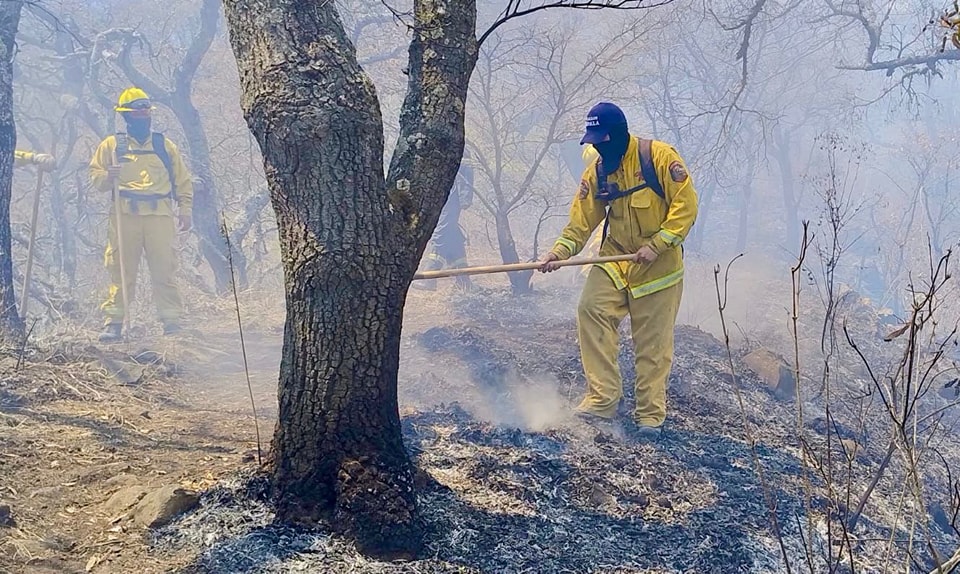
Árboles de diversas especies fueron consumidos por el fuego. Foto: cortesía.
La tarde del lunes 25 de marzo, la Secretaría del Medio Ambiente y Desarrollo Territorial (SEMADET) activó la alerta atmosférica para el municipio de Ixtlahuacán de los Membrillos.
El miércoles 27 de marzo, el gobernador de Jalisco Enrique Alfaro escribió en sus redes sociales: “ se prevé que en las próximas horas quede controlado y pronto extinguido”.
Cinco brigadistas han resultado lesionados en el servicio, uno por quemaduras de primer grado en el rostro, otro por picaduras de abejas y tres más por intoxicación.
Dos helicópteros cisterna llamados “Witari” del Gobierno de Jalisco y el “Palomo” del Gobierno de Tlajomulco de Zúñiga, participan en el control del incendio.
El estado de fuerza de brigadistas subió de 115 a 128 durante la tarde y noche del 27 de marzo, aunado a decenas de voluntarios que trabajan fuera de la línea de fuego.
Las columnas de humo se pueden apreciar desde el frente del lago de Chapala.
Los brigadistas continúan luchando para que el incendio no alcance la Chupinaya, la punta de la montaña en los cerros de Ajijic. Un lugar con una extensa flora y fauna.
Reporta Protección Civil y Bomberos de Chapala control del apenas el 75% del incendio.
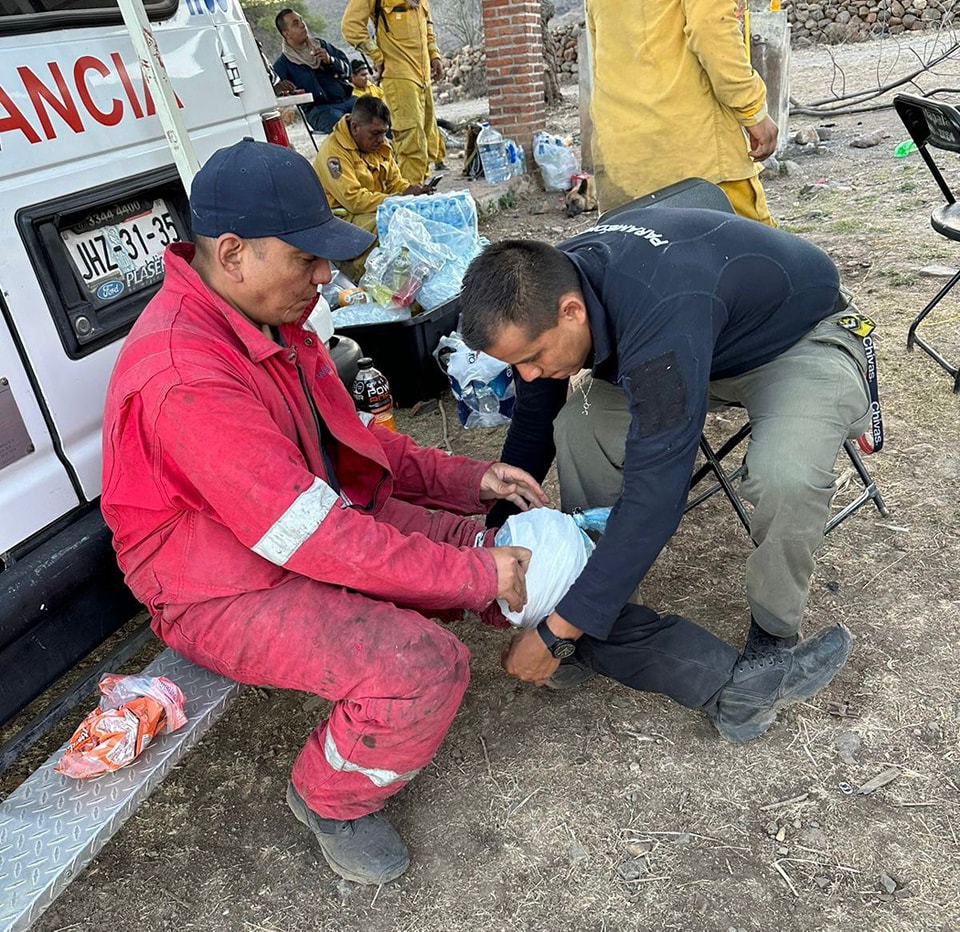
Uno de los brigadistas recibiendo atención médica. Foto: cortesía.
Reparan colapso de tuberías de drenaje que provocaron derrames en playas de Ajijic
Derrame en la calle Río Zula. Testigos aseguran que tiene al menos un año tirándose el agua de drenaje. Foto: Sofía Medeles.
Sofía Medeles.- Se encuentra en reparación un colapso en tuberías de drenaje que causaron una constante tira de aguas negras en al menos dos zonas de Ajijic. Según comentaron vecinos de la zona, la tira de drenaje tenía al menos un año, donde se reportó constantemente, sin embargo, no se había atendido.
Una de las principales tiras de agua de drenaje, se localizó en la calle Río Zula. La tira continua, y se ha esparcido y estancado en la playa de esa zona. Por otro lado, otra de las zonas con constantes tiras, fue en la zona de la plaza de la calle Flores Magón, donde los trabajadores del Sistema Municipal de Agua Potable y Alcantarillado (SIMAPA) han estado trabajando.

Vactor haciendo limpieza en las tuberías recién colocadas. Foto: Sofía Medeles.
Según compartió el encargado de SIMAPA Ajijic, Rafael Escamilla, estas son reparaciones a algunos colapsos detectados en las tuberías. «Las tuberías se colocaron en 1987, tienen 37 años ya. El agua en Río Zula se ha derramado por la reparación que se ha estado haciendo en Flores Magón. Se tiene que cortar el flujo para poder trabajar bien y que quede listo pronto.
Un testimonio de uno de los vecinos de la zona, aseguró que conforme pasa el tiempo, los olores aumentan, y el problema empeora. «Lleva al menos un año. Se ha estado reportando constantemente por vecinos que viven cerca del registro, pero no han venido ni arreglado. Últimamente por el calor, el olor ha aumentado y ha alcanzado un mayor rango».
Por su parte, uno de los trabajadores que se encontraban en la zona de la reparación, en la calle Flores Magón, comentó que se trata de un problema que hubo con un colapso en la tubería de drenaje. Este, fue provocado por la antigüedad de los tubos, así como el peso de un muro que se construyó sobre estas. Este, se encontraría en la zona de playa entre las calles Flores Magón y la calle Linda Vista.
«Se intentó limpiar con el vactor y varillas, pero no funcionó porque está colapsado. Se optó por cambiar el tubo. Se van a trabajar cien metros entre las calles Francisco Villa y Linda Vista, pero una parte se hará después de vacaciones de Semana Santa. Hasta ahora, se ha trabajado de Flores Magón hacia el poniente. Este colapso provocó el derrame de Río Zula al no dejar fluir el agua de drenaje», mencionó.
Rafael, comentó que se seguirá reparando. «Todo eso se va a acomodar. El vactor está desazolvando para que no haya problemas de derrame por falta de mantenimiento, se está previniendo todo. Lo que ocurrió son colapsos, pero conforme pasan, se corrigen poco a poco, también para evitar tener un escarbadero en la zona, que pueda afectar», concluyó.
Dona Chapala mil 500 árboles y plantas a escuelas del municipio
A cada institución educativa se le entregaron de tres a cinco decenas de árboles, plantas y un certificado de Escuela Verde. Foto: Gobierno de Chapala.
Jazmín Stengel.- El invernadero municipal repartió mil 500 árboles y plantas endémicas a 13 escuelas del municipio de Chapala, con el fin de crear conciencia sobre el cuidado al medio ambiente entre los más jóvenes, mediante el programa “Creciendo Juntos”; así como un certificado que avala a los planteles como “Escuela Verde”.
Cada institución educativa recibió entre 30 y 50 ejemplares, entre árboles de guamúchil y guayabo, y plantas de romero, limón, orégano, ceiba y chiles, entre otras especies del ecosistema local, informó Joaquín Madrigal, encargado del vivero municipal, durante la entrega pública efectuada en la Plaza de la Hermandad, el 15 de febrero.
Los árboles entregados forman parte de los 10 mil ejemplares que Madrigal sembró desde la reactivación del vivero municipal, durante la actual administración 2021-2024.
Esta práctica de regalar árboles para que los alumnos y maestros los planten en los diferentes planteles educativos, tiene como objetivo crear conciencia del medio ambiente y la purificación de aire que generan, entre los más jóvenes.
“Esta experiencia les dará una perspectiva del cuidado del medio ambiente y cuando sean adultos podrán ser testigos del fruto de sus ciudades, y contribuido a la purificación del aire y la recreación de la vida silvestre”, añadió Lilia Alvarado Macías, Secretaria General durante la entrega de árboles.
Capacitan a funcionarios y alumnos sobre el cuidado del Lago de Chapala
Funcionarios públicos y agentes que fueron capacitados por Corazón de la Tierra para dar talleres a los alumnos de Poncitlán y Chapala sobre los cuidados del Lago de Chapala. Foto: Corazón de la Tierra.
Jazmín Stengel.- En el marco del Día Internacional de los Humedales, 2 de febrero, la Asociación Corazón de la Tierra capacitó a funcionarios públicos y alumnos de diversas escuelas en Chapala y Poncitlán sobre las problemáticas y cuidados que el Lago de Chapala requiere en la actualidad.
“El propósito fue capacitar a personas que a su vez impartirán talleres a estudiantes, desde nivel primaria hasta bachillerato”, informó la Asociación mediante sus redes sociales.
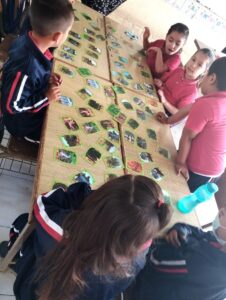
Decenas de memoramas fueron entregados a alumnos de Poncitlán y Chapala como material didáctico, con el fin de crear conciencia sobre el medio ambiente. Foto: Corazón de la Tierra.
Durante estas capacitaciones a funcionarios públicos, agentes y alumnos, se repartió material didáctico, para la aplicación de los talleres. Los materiales para cada municipio incluye guías de biología, carteles geográficos y de biodiversidad, así como un memorama llamado “Chapala, un lago vivo”.
A Chapala le tocaron 11 memoramas y 21 juegos de carteles, pero la dirección de Ecología realizó la petición para recibir más material y poder cubrir la necesidad de todas las escuelas del municipio, informó Comunicación Social.
Los talleres tienen como objetivo concientizar a la población de los principales problemas que sufre el Lago de Chapala en la actualidad, la contaminación directa al lago por parte de residuos tanto industriales como urbanos, la hipernutrimentación del agua, es decir el exceso de fertilizantes en la zona y la sobre explotación en beneficio del hombre.
En los talleres también se tocará el tema del cuidado del agua por parte de los ciudadanos, como evitar tirar basura en el lago, contaminantes y sustancias dañinas para el ecosistema lacustre.
Durante el simposio realizado del 2 de febrero en el Hotel Real de Chapala, se declaró que una de las primeras causas que afectan al lago más grande de México, son los permisos que diferentes gobiernos han otorgado al sector privado, sin un correcto análisis previo y que dan paso a actividades que contaminan el ecosistema.
© 2016. Todos los derechos reservados. Semanario de la Ribera de Chapala


